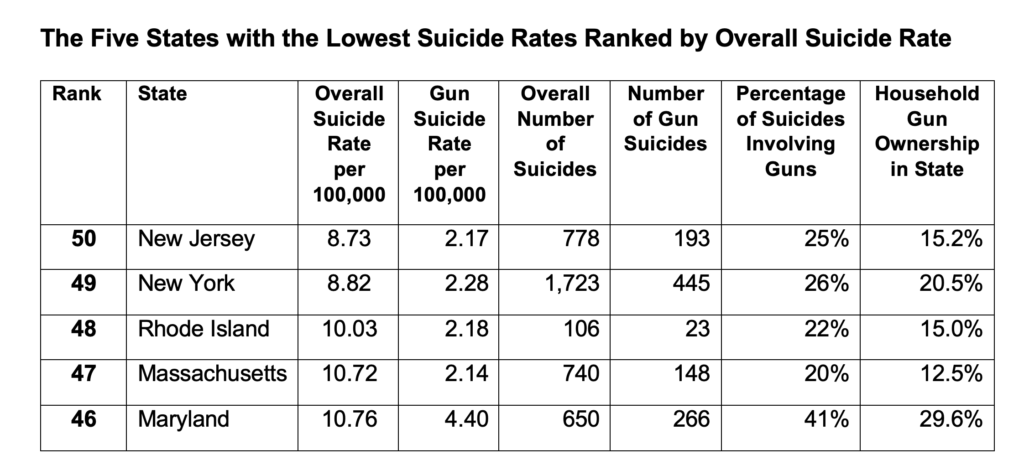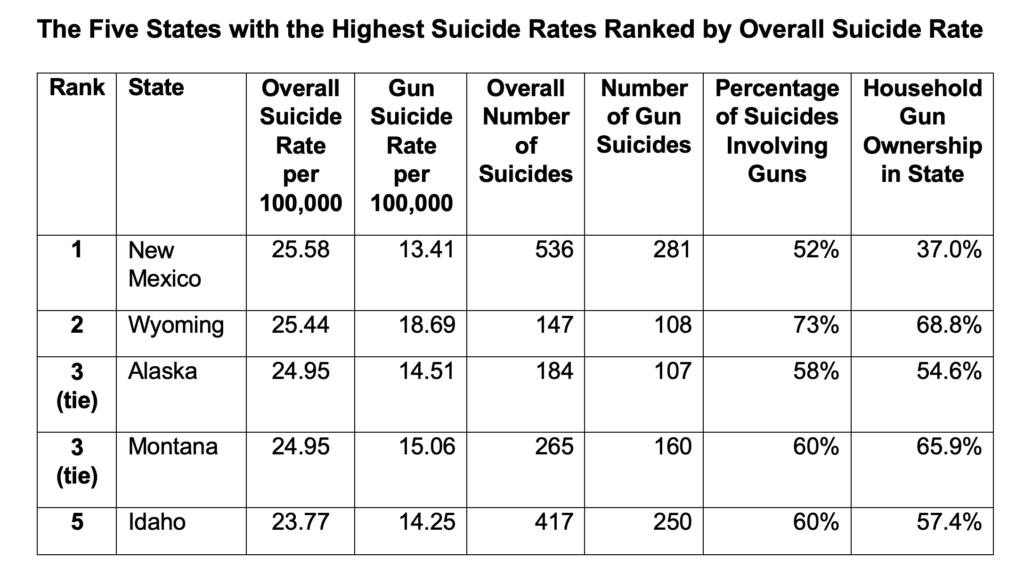For Release: Thursday, September 17, 2020
New VPC Analysis Released During National Suicide Prevention Awareness Month in September
Washington, DC — States with lower rates of gun ownership and strong gun violence prevention laws have the lowest overall suicide rates in the nation according to a new Violence Policy Center (VPC) analysis of 2018 data (the most recent year available) from the Centers for Disease Control and Prevention’s National Center for Injury Prevention and Control. Conversely, states with the highest suicide rates are dominated by states with high gun ownership rates (four out of the top five) and weak gun violence prevention laws.
The tables below list the five states with the five lowest and highest overall suicide rates in 2018 and include for each state its overall suicide rate, gun suicide rate, total number of suicides and gun suicides, percentage of suicides that involved a gun, and household gun ownership rate. A similar table for all 50 states ranked by overall suicide rate is available at https://vpc.org/wp-content/uploads/2020/09/State-Overall-Suicide-Rates-ranked-by-rate.pdf.
The state with the lowest overall suicide rate in 2018 was New Jersey (8.73 suicides per 100,000 residents) with a gun suicide rate of 2.17 gun suicides per 100,000 residents. New York ranked second lowest (overall suicide rate of 8.82 suicides per 100,000 residents) and had a gun suicide rate of 2.28 gun suicides per 100,000 residents. Rhode Island ranked third lowest (overall suicide rate of 10.03 suicides per 100,000 residents) and had a gun suicide rate of 2.18 gun suicides per 100,000 residents. In each of these three states guns were used in 26 percent or fewer of the suicides reported that year. Compared to the states with the highest suicide rates, each of these states has strong gun violence prevention laws as well as a lower rate of gun ownership.

The state with the highest overall suicide rate in the nation in 2018 was New Mexico (25.58 suicides per 100,000 residents), which had the sixth highest gun suicide rate (13.41 gun suicides per 100,000 residents). Wyoming ranked second (25.44 suicides per 100,000 residents) and had the highest gun suicide rate (18.69 gun suicides per 100,000 residents). Alaska tied for third (24.95 suicides per 100,000 residents) and had the third highest gun suicide rate (14.51 gun suicides per 100,000 residents). Montana tied for third (24.95 suicides per 100,000 residents) and had the second highest gun suicide rate (15.06 gun suicides per 100,000 residents). In each of these four states guns were used in 50 percent or more of the suicides reported that year and all, except for New Mexico, had a household gun ownership rate above 50 percent). Compared to the states with the lowest suicide rates, each of these states has lax gun violence prevention laws.

VPC Executive Director Josh Sugarmann states, “Suicide is the most common type of gun death in America and the use of a firearm is the key factor in whether a suicide attempt is completed or not. Unfortunately this clear and well documented public health threat will likely only increase as the result of firearms purchased during COVID-19 and the continuing stress placed on American families as we work to battle this pandemic.”
As shown in the VPC’s Guns and Suicide fact sheet (https://vpc.org/wp-content/uploads/2020/06/suicide-factsheet-2020.pdf), in 2018, the national overall suicide rate was 14.78 per 100,000 and the gun suicide rate was 7.47 per 100,000. That year there were 48,344 suicides in the United States: 132 suicides per day; one suicide every 10.9 minutes. More than half (50.5 percent) of these were firearm suicides, which totaled 24,432 in 2018.
State suicide and gun suicide rates are calculated by dividing the number of relevant suicide deaths by the total state population and multiplying the result by 100,000 to obtain the rate per 100,000, which is the standard and accepted method for comparing fatal levels of gun violence.
The VPC defined states with “weak” gun violence prevention laws as those that add little or nothing to federal law and have permissive laws governing the open or concealed carrying of firearms in public. States with “strong” gun violence prevention laws were defined as those that add significant state regulation that is absent from federal law, such as restricting access to particularly hazardous and deadly types of firearms (for example, assault weapons), setting minimum safety standards for firearms and/or requiring a permit to purchase a firearm, and restricting the open and concealed carrying of firearms in public.
State gun ownership rates were obtained from the July 2019 American Journal of Preventative Medicine article by Aaron J. Kivisto, et al., “Firearm Ownership and Domestic Versus Nondomestic Homicide in the U.S.,” which is the most recent comprehensive published data available on state gun ownership.
***
The Violence Policy Center is a national educational organization working to stop gun death and injury. Follow the VPC on Twitter and Facebook.






